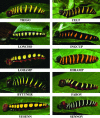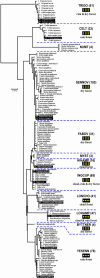Ten species in one: DNA barcoding reveals cryptic species in the neotropical skipper butterfly Astraptes fulgerator
- PMID: 15465915
- PMCID: PMC522015
- DOI: 10.1073/pnas.0406166101
Ten species in one: DNA barcoding reveals cryptic species in the neotropical skipper butterfly Astraptes fulgerator
Abstract
Astraptes fulgerator, first described in 1775, is a common and widely distributed neotropical skipper butterfly (Lepidoptera: Hesperiidae). We combine 25 years of natural history observations in northwestern Costa Rica with morphological study and DNA barcoding of museum specimens to show that A. fulgerator is a complex of at least 10 species in this region. Largely sympatric, these taxa have mostly different caterpillar food plants, mostly distinctive caterpillars, and somewhat different ecosystem preferences but only subtly differing adults with no genitalic divergence. Our results add to the evidence that cryptic species are prevalent in tropical regions, a critical issue in efforts to document global species richness. They also illustrate the value of DNA barcoding, especially when coupled with traditional taxonomic tools, in disclosing hidden diversity.
Figures



Similar articles
-
Reading the complex skipper butterfly fauna of one tropical place.PLoS One. 2011;6(8):e19874. doi: 10.1371/journal.pone.0019874. Epub 2011 Aug 16. PLoS One. 2011. PMID: 21857895 Free PMC article.
-
DNA barcodes and cryptic species of skipper butterflies in the genus Perichares in Area de Conservacion Guanacaste, Costa Rica.Proc Natl Acad Sci U S A. 2008 Apr 29;105(17):6350-5. doi: 10.1073/pnas.0712181105. Epub 2008 Apr 24. Proc Natl Acad Sci U S A. 2008. PMID: 18436645 Free PMC article.
-
Nuclear genomes distinguish cryptic species suggested by their DNA barcodes and ecology.Proc Natl Acad Sci U S A. 2017 Aug 1;114(31):8313-8318. doi: 10.1073/pnas.1621504114. Epub 2017 Jul 17. Proc Natl Acad Sci U S A. 2017. PMID: 28716927 Free PMC article.
-
Mitochondrial and nuclear phylogenetic analysis with Sanger and next-generation sequencing shows that, in Área de Conservación Guanacaste, northwestern Costa Rica, the skipper butterfly named Urbanus belli (family Hesperiidae) comprises three morphologically cryptic species.BMC Evol Biol. 2014 Jul 9;14:153. doi: 10.1186/1471-2148-14-153. BMC Evol Biol. 2014. PMID: 25005355 Free PMC article.
-
Beyond the colours: discovering hidden diversity in the Nymphalidae of the Yucatan Peninsula in Mexico through DNA barcoding.PLoS One. 2011;6(11):e27776. doi: 10.1371/journal.pone.0027776. Epub 2011 Nov 23. PLoS One. 2011. PMID: 22132140 Free PMC article.
Cited by
-
DNA barcoding of Japanese earwig species (Insecta, Dermaptera), with sequence diversity analyses of three species of Anisolabididae.Biodivers Data J. 2023 Sep 27;11:e107001. doi: 10.3897/BDJ.11.e107001. eCollection 2023. Biodivers Data J. 2023. PMID: 38318508 Free PMC article.
-
Genomics reveals a new genus and species from a single female specimen (Lepidoptera: Hesperiidae: Hesperiinae: Hesperiini: Moncina).Insecta mundi. 2022 Oct 14;2022:0957. Insecta mundi. 2022. PMID: 36275857 Free PMC article.
-
New approaches narrow global species estimates for beetles, insects, and terrestrial arthropods.Proc Natl Acad Sci U S A. 2015 Jun 16;112(24):7519-23. doi: 10.1073/pnas.1502408112. Epub 2015 Jun 1. Proc Natl Acad Sci U S A. 2015. PMID: 26034274 Free PMC article.
-
Taxonomic and identification review of adventive Fiorinia Targioni Tozzetti (Hemiptera, Coccomorpha, Diaspididae) of the United States.Zookeys. 2021 Oct 27;1065:141-203. doi: 10.3897/zookeys.1065.69171. eCollection 2021. Zookeys. 2021. PMID: 36452345 Free PMC article.
-
Guiding Classical Biological Control of an Invasive Mealybug Using Integrative Taxonomy.PLoS One. 2015 Jun 5;10(6):e0128685. doi: 10.1371/journal.pone.0128685. eCollection 2015. PLoS One. 2015. PMID: 26047349 Free PMC article.
References
-
- Walch, J. E. I. (1775) Naturforscher 7, 113–116, plate 1.
-
- Janzen, D. H. (2003) in Arthropods of Tropical Forests. Spatio-temporal Dynamics and Resource Use in the Canopy, eds. Basset, Y., Novotny, V., Miller, S. E. & Kitching, R. L. (Cambridge Univ. Press, Cambridge, U.K.), pp. 369–379.
-
- Gauld, I. D. & Janzen, D. H. (2004) Zoo. J. Linn. Soc. 141, 297–351.
-
- Janzen, D. H. (2004) in Biodiversity Conservation in Costa Rica, eds. Frankie, G. W., Mata, A. & Vinson, S. B. (Univ. of California Press, Berkeley), pp. 80–96.
-
- Burns, J. M. & Janzen, D. H. (2001) J. Lepid. Soc. 55, 15–43.
Publication types
MeSH terms
Substances
Associated data
- Actions
- Actions
- Actions
- Actions
- Actions
- Actions
- Actions
- Actions
- Actions
- Actions
- Actions
- Actions
- Actions
- Actions
- Actions
- Actions
- Actions
- Actions
- Actions
- Actions
- Actions
- Actions
- Actions
- Actions
- Actions
- Actions
- Actions
- Actions
- Actions
- Actions
- Actions
- Actions
- Actions
- Actions
- Actions
- Actions
- Actions
- Actions
- Actions
- Actions
- Actions
- Actions
- Actions
- Actions
- Actions
- Actions
- Actions
- Actions
- Actions
- Actions
- Actions
- Actions
- Actions
- Actions
- Actions
- Actions
- Actions
- Actions
- Actions
- Actions
- Actions
- Actions
- Actions
- Actions
- Actions
- Actions
- Actions
- Actions
- Actions
- Actions
- Actions
- Actions
- Actions
- Actions
- Actions
- Actions
- Actions
- Actions
- Actions
- Actions
- Actions
- Actions
- Actions
- Actions
- Actions
- Actions
- Actions
- Actions
- Actions
- Actions
- Actions
- Actions
- Actions
- Actions
- Actions
- Actions
- Actions
- Actions
- Actions
- Actions
- Actions
- Actions
- Actions
- Actions
- Actions
- Actions
- Actions
- Actions
- Actions
- Actions
- Actions
- Actions
- Actions
- Actions
- Actions
- Actions
- Actions
- Actions
- Actions
- Actions
- Actions
- Actions
- Actions
- Actions
- Actions
- Actions
- Actions
- Actions
- Actions
- Actions
- Actions
- Actions
- Actions
- Actions
- Actions
- Actions
- Actions
- Actions
- Actions
- Actions
- Actions
- Actions
- Actions
- Actions
- Actions
- Actions
- Actions
- Actions
- Actions
- Actions
- Actions
- Actions
- Actions
- Actions
- Actions
- Actions
- Actions
- Actions
- Actions
- Actions
- Actions
- Actions
- Actions
- Actions
- Actions
- Actions
- Actions
- Actions
- Actions
- Actions
- Actions
- Actions
- Actions
- Actions
- Actions
- Actions
- Actions
- Actions
- Actions
- Actions
- Actions
- Actions
- Actions
- Actions
- Actions
- Actions
- Actions
- Actions
- Actions
- Actions
- Actions
- Actions
- Actions
- Actions
- Actions
- Actions
- Actions
- Actions
- Actions
- Actions
- Actions
- Actions
- Actions
- Actions
- Actions
- Actions
- Actions
- Actions
- Actions
- Actions
- Actions
- Actions
- Actions
- Actions
- Actions
- Actions
- Actions
- Actions
- Actions
- Actions
- Actions
- Actions
- Actions
- Actions
- Actions
- Actions
- Actions
- Actions
- Actions
- Actions
- Actions
- Actions
- Actions
- Actions
- Actions
- Actions
- Actions
- Actions
- Actions
- Actions
- Actions
- Actions
- Actions
- Actions
- Actions
- Actions
- Actions
- Actions
- Actions
- Actions
- Actions
- Actions
- Actions
- Actions
- Actions
- Actions
- Actions
- Actions
- Actions
- Actions
- Actions
- Actions
- Actions
- Actions
- Actions
- Actions
- Actions
- Actions
- Actions
- Actions
- Actions
- Actions
- Actions
- Actions
- Actions
- Actions
- Actions
- Actions
- Actions
- Actions
- Actions
- Actions
- Actions
- Actions
- Actions
- Actions
- Actions
- Actions
- Actions
- Actions
- Actions
- Actions
- Actions
- Actions
- Actions
- Actions
- Actions
- Actions
- Actions
- Actions
- Actions
- Actions
- Actions
- Actions
- Actions
- Actions
- Actions
- Actions
- Actions
- Actions
- Actions
- Actions
- Actions
- Actions
- Actions
- Actions
- Actions
- Actions
- Actions
- Actions
- Actions
- Actions
- Actions
- Actions
- Actions
- Actions
- Actions
- Actions
- Actions
- Actions
- Actions
- Actions
- Actions
- Actions
- Actions
- Actions
- Actions
- Actions
- Actions
- Actions
- Actions
- Actions
- Actions
- Actions
- Actions
- Actions
- Actions
- Actions
- Actions
- Actions
- Actions
- Actions
- Actions
- Actions
- Actions
- Actions
- Actions
- Actions
- Actions
- Actions
- Actions
- Actions
- Actions
- Actions
- Actions
- Actions
- Actions
- Actions
- Actions
- Actions
- Actions
- Actions
- Actions
- Actions
- Actions
- Actions
- Actions
- Actions
- Actions
- Actions
- Actions
- Actions
- Actions
- Actions
- Actions
- Actions
- Actions
- Actions
- Actions
- Actions
- Actions
- Actions
- Actions
- Actions
- Actions
- Actions
- Actions
- Actions
- Actions
- Actions
- Actions
- Actions
- Actions
- Actions
- Actions
- Actions
- Actions
- Actions
- Actions
- Actions
- Actions
- Actions
- Actions
- Actions
- Actions
- Actions
- Actions
- Actions
- Actions
- Actions
- Actions
- Actions
- Actions
- Actions
- Actions
- Actions
- Actions
- Actions
- Actions
- Actions
- Actions
- Actions
- Actions
- Actions
- Actions
- Actions
- Actions
- Actions
- Actions
- Actions
- Actions
- Actions
- Actions
- Actions
- Actions
- Actions
- Actions
- Actions
- Actions
- Actions
- Actions
- Actions
- Actions
- Actions
- Actions
- Actions
- Actions
- Actions
- Actions
- Actions
- Actions
- Actions
- Actions
- Actions
LinkOut - more resources
Full Text Sources
Other Literature Sources

